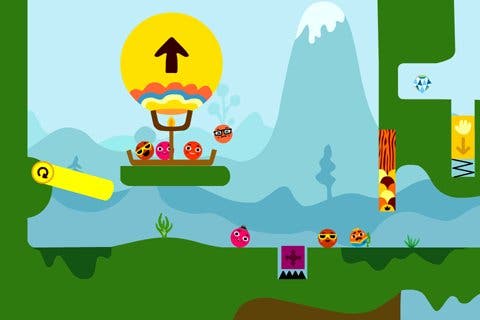Rolando
Starring roll.
Rolando may have a lot in common with LocoRoco - simple, colourful graphics free from outlines and textures, smiling, charismatic blobs and tilt-based controls - but it's a forgivably cynical way to catch the attention of App Store browsers; a split-second sales-pitch in a market where pixels and prose are at a premium. As a strategy it's not without risk, either: LocoRoco is a fond memory, and tarnishing it would imperil the goodwill ngmoco has built up with its cheap and cheerful catalogue of early releases. Ultimately it's shrewd, if slightly disappointing, because Rolando is its own game, among the best the iPhone has to offer, and would still have been had the developer, HandCircus, come up with its own signature visuals.
The first and most obvious distinction between Rolando and LocoRoco is that rolandos only react to players tilting the screen once they have been selected, either individually with a tap or as a group with a drag-box. Otherwise they stand still, immune to your input. Once under your control, they can be made to jump by an upward flick of the thumb, or deselected with a quick tap on an empty part of the screen, and this brings them to a near-instant standstill. Immediately Rolando overcomes one of LocoRoco's biggest issues - regularly losing control of disparate blobs and suffering the consequences - and shows similar restraint in its economical use of the iPhone touch-screen.
The goal is still to transport as many of the creatures under your control to the end as possible, but levels are short, and split up further still by state-saving checkpoint balloons, while rolando-killing enemies are set on specific repeating movement paths, and don't roam off-course looking for a frustrating fight, like LocoRoco's Mojas. The tilt controls are also precisely calibrated: rolandos take a split second to speed up, and there's an appreciable deadzone to soften the initial lurch. Staying in control and out of trouble is in your hands, but supported by HandCircus, and it's hard not to conclude that Rolando's developers weren't just conscious of the tilt-and-touch control system's potential imprecision, but obsessed with it.

Whether because of that or in spite of it, they have created a manageably paced and well-considered puzzle game rather than a network of rail-riding rollercoasters, aerial displays and unlockables. The first thing you do upon starting most levels is not barrel to the right, but place two fingers on the screen to drag the camera around to take in your surroundings, before deciding how to proceed through the generally non-linear layout. A measured approach is often more important than reflexes and guile.
For instance, you may have to use a spiky commando - a particular kind of rolando that can cling to any surface - to climb to an elevated switch, or retrieve a block to fill in a hazardous spike pit, before moving other rolandos through to safety. These may include rolando royalty, like the energetic prince, who races away on his own until he hits a wall and turns back, and needs to be buffered by rolando civilians to negotiate moving platforms and roll past dangling enemies.


